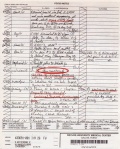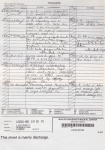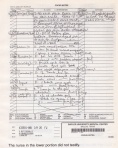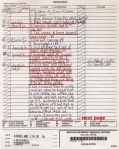The Nurses
A litany of medical personnel were called to testify at the trial of Darlie Routier in 1997. The prosecution called nurses and doctors who treated Darlie at the Baylor Medical Center to testify about their experiences with her. The testimony provided at trial was contradictory to the notes recorded in Darlie’s medical records during her hospital stay. This page examines the contradictions that were presented in court. It is also important to note that several nurses who attended to Darlie during her stay were not called by the prosecution to testify.
On the 6th of June, medical notes indicate that Darlie’s family was at her bedside continuously. One note reads: “Encouraged family members to allow pt. to rest + avoid talking to pt. or mentioning the assault”.
Various notations also indicated that she was regularly receiving pain medication (and sometimes anxiety medication). She was under the influence of this medication when questioned by police. She repeatedly maintained her home was broken into and that an intruder attacker her and her children.
Dr. Patrick Dillawn
On June 6 of 1996, Doctor Dillawn was working when Darlie was brought into the emergency department. He testified about her injuries, the surgery performed on her neck, and her demeanor during the time he interacted with her.
Prosecutor Toby Shook questioned him and asked about his experience with shock and trauma. He asked Dr. Dillawn to describe Darlie’s emotional state and he said that she seemed agitated about the police being there and photographing her. He went on to say, “She did not seem particularly upset other than that”.
Shook asked the doctor if he saw tears streaming down Darlie’s face and he answered, “At the end of my visit she did cry a little bit. She had a photograph of her children in her hand. And then she cried a little bit”.
However, that was not what the doctor recorded in his notes. In the report below, that he wrote and signed, Dr. Dillawn described Darlie as “tearful” and “frightened”.
The doctor was asked on cross-examination if he read through the notes made by the nurses who attended to Darlie, over the course of her stay at the hospital, and he stated that he had not.
He was asked if he would be surprised to learn that over the course of her three-day stay various nurses described her as tearful, frightened, and upset. He responded by saying, “No, it would not surprise me.”
Indeed it shouldn’t have since that is exactly what the nurses recorded throughout their notes, contrary to statements later made on the stand.
Jody Fitts
Fitts was a registered nurse at Baylor Medical Center in June of 1996 when Darlie was transported to the hospital and underwent surgery pertaining to her neck injury. Fitts testified he was on duty during the early morning hours when Darlie was admitted.
Under direct examination the nurse testified that when Darlie was first brought into the emergency department she was hysterical and screaming. Fitts observed her asking why someone would kill her boys. Her clothes had been completely removed and Fitts said she was “covered head to toe in dried blood”.
He described Darlie’s wounds – including her neck wound which spurted blood when touched by one of the surgeons. He also mentioned the necklace that was embedded in the wound and “freed” when the nurse removed the bandage the paramedics had applied. His testimony implied the necklace was not embedded in the wound, but if it had been loose around Darlie’s neck it would have been removed, along with all her other clothing while she was initially treated.
The necklace is contained in an evidence room in Dallas, Texas. Nicks made by the knife that cut Darlie’s throat are visible in the chain in two spots. Below are pictures of each.
Fire department employee Byford testified that he observed the necklace on Darlie before she arrived at the hospital. He tried to remove it but it caused her pain and so he left it there.
Fitts testified that he removed the necklace and that it was “unattached”, meaning he did not have to undo it.
He testified that Darlie was able to answer questions.
The defense did not cross examine Fitts.
Christopher Wielgosz
Wielgosz worked as a nurse in the intensive care unit at Baylor University Medical Center. He was working when Darlie was brought to the ICU from the operating room where she had surgery on her neck earlier that morning.
Wielgosz testified that the first comment Darlie made in his presence was, “How could anyone do this to my children?” He did not ask her any questions about what had happened to her, but he was aware that she had been “involved in a trauma” and that two of her children had also been involved.
He stated that she repeated her question about how someone could do something like that to her children. Then he said that she mentioned the attacker dropping a knife and Darlie stating she had picked it up and was worried that she had “obscured the attacker’s fingerprints”.
Though the nurse stated that Darlie was alert and aware, he acknowledged that the comments she made were not consistent. “She wasn’t speaking consistently,” he testified and explained she would make those kinds of comments “periodically”.
He testified that he gave her pain medication in the form of 25 milligrams of Demerol combined with a drug called Phenergan. This medication was administered to her shortly before she was questioned by the police.
Wielgosz testified that while Darlie was in his care “she was — her eyes were tearful, but she had a very flat affect”. It was a curious statement considering what he recorded in his notes about how she was “crying” and “visibly upset”. He mentioned nothing in the notes about her having a “flat affect” as illustrated below.
Wielgosz indicated under cross-examination that he had been called to the Rowlett Police Department to make a statement. He also stated that he had spoken to prosecutor Shook the day before he testified. The nurses called to testify stayed together prior to giving their testimony at the Holiday Inn. He acknowledged that they all sometimes ate together during that stay.
Jody Cotner
Jody Cotner was a trauma nurse at Baylor in June of 1996. She arrived at the hospital around 8 a.m. the morning Darlie was admitted. Her first encounter with her occurred while Darlie was in bed in the ICU.
Cotner recounted meeting Darlie, testifying that she introduced herself and then asked Darlie about what happened. She stated that Darlie told her about the attack and described chasing her attacker and picking up the knife. She then testified she met with Darlie periodically throughout the day.
She also downplayed Darlie’s emotional state, suggesting that she was not grieving as a mother normally would. However, on cross-examination she testified that she had not taken any notes in reference to Darlie because she did “not do direct patient care in the intensive care unit”. She did help to change and dress Darlie’s injuries though.
The issue of the bruising came up during cross-examination and the nurse was resistant to admitting that it would be negligent for any of the nurses to fail to note bruising on Darlie while she was in the hospital. She also provided a vague range for which she believed bruising observed on one of the photographs presented as an exhibit could have been caused, suggesting a time frame that would have occurred while Darlie was still in the hospital. However, when challenged on this point she admitted that it was unlikely Darlie received that kind of blunt force trauma while under the care of the hospital. She also agreed there was a wide range of time in which the bruising could have occurred.
Diane Hollon
Hollon was another nurse at Baylor who testified at Darlie’s trial. She described getting to the hospital at 6:45 a.m. She came into contact with Darlie around 8 a.m. She testified about Darlie’s demeanor, saying that she “didn’t show a whole lot of emotions”. She did admit to charting that Darlie “would get tearful”.
She stated that Darlie would touch her boys’ pictures, become tearful, and make statements about how she could not believe her babies were gone. Hollon testified Darlie did this several times throughout the day that she was with her.
Hollon, like the other nurses, minimized Darlie’s expression of emotion during her hospital stay. However, a prior nurse’s brief notes regarding Darlie’s demeanor, approximately a half hour before Hollon received her, reported Darlie was “very emotional” and had “periods of crying/sobbing”.
It is unclear who made that particular notation. It does not appear to have been Wielgosz because he signed his notations with his initials and he also included the year in the date portion. The notation was made a half hour before Hollon received Darlie and so it was not likely her writing. Who was it? Why were they not called to testify? Whoever the person was indicated that Darlie became “very emotional” while “talking about events + family”. If put on the stand, would they have contradicted the other nurses’ testimony?
Hollon tried to downplay Darlie’s emotional state by claiming something that contradicted the previous nurse’s notation, saying: “She never did actually burst out crying, sobbing, nothing like that”.
She admitted to having met with the prosecutors on multiple occasions before she testified as well.
Paige Campbell
Campbell testified on behalf of the prosecution as well. She claimed that Darlie was not emotional and that she never saw a tear run down Darlie’s face. It was yet another odd claim since her notes indicated Darlie was “very tearful”. She also stated in the notes that Darlie asked to have a family member in her room with her at all times, indicating her need for support and her fear of being alone after such a traumatic event. Campbell indicated emotional support was given to Darlie in response to her emotional state.
On the stand Campbell tried to trivialize Darlie’s expression of emotion just as the other nurses had done. She never gave a plausible explanation about the contradiction between the notes and her testimony.
Denise Faulk
Faulk was another nurse at Baylor. She came in contact with Darlie late in the evening of the 6th and attended to her until 7 a.m. the following morning. She testified that at one point Darlie described the attack, stating that she had wrestled with a man.
Faulk said that Darlie was not crying when she relayed the story and that she saw her eyes get wet, but “never really saw tears go down her face”.
However, in her notes she wrote, “Pt. tearful @ times”. She also noted that the family provided emotional support and that Darlie was encouraged to rest.
Others Who Didn’t Testify
There were at least four nurses recorded throughout the notes who were not called to testify by the prosecutor. The defense did not call these nurses to the stand either. However, there was much the defense did not do that they should have such as conduct their own independent DNA testing and enter the prayer vigil video that took place before the silly string video – to name just two.
A chaplain attended to Darlie around 9:00 a.m. and recorded two notes on the page containing notations about her discharge. He appeared to have spent at least one hour with her because he made a second notation at 10:00 a.m. The name appears to read “Don Hicks” or “Don Hick”. The prosecution never called him to testify about Darlie’s lack of emotion and he noted that upon meeting with her she was “very upset”.
A number of nurses were never called to testify, including the one referenced above who described Darlie as “crying/sobbing”.
Another unknown person attended to Darlie throughout the 7th, but did not testify at trial. Notations provided by that individual are below (lower half of page).
A nurse by the name of V. McCright made notations about attending to Darlie on the 7th as well. The person reported that Darlie was “tearful”. The notes are below.
Finally, a nurse with the last name of “Fisher” attended to Darlie the evening of the 7th and into the morning of the 8th. The person noted that a guard was posted outside until midnight and that when there was no one there, Darlie’s husband Darin became upset. The notes are below.
Who were these people? If what they observed matched the other nurses’ claims on the stand, why weren’t they called to testify against Darlie as well? If they had testified that Darlie was emotional and grieving (as the various notes strongly suggest) would it have influenced the jury to acquit Darlie?
Links to the Notes
The notes (focus notes) referenced above may be viewed by clicking on the following links.
Notes taken on the 6th and 7th










